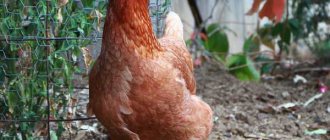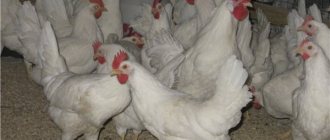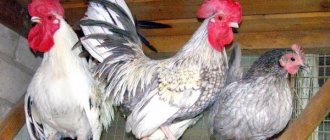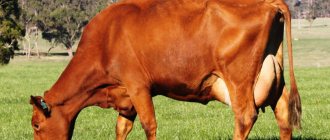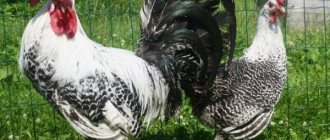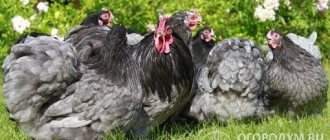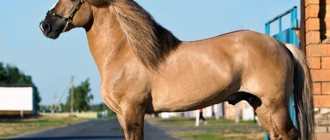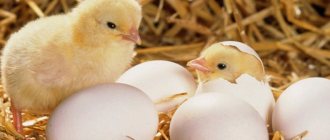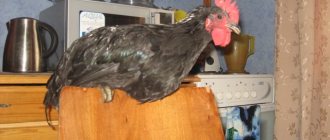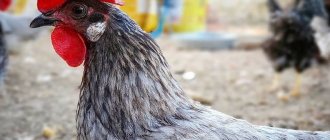Poultry farming » Chickens
0
1744
Article rating
Kira Stoletova
Chicken is traditionally considered one of the most popular poultry all over the world. Its domestication occurred about 2000 years ago BC. e. Presumably, the first wild jungle specimens were domesticated in Asian latitudes. Nowadays, poultry is actively bred for meat and eggs; chicken feathers and down are also valued. Breeders have developed many productive species, one of which will be discussed in the article. So, get acquainted: the Leningrad breed of chickens and its varieties.
Leningrad chicken breeds
Description of the breed
Externally, Leningrad White chickens and roosters differ only in general sexual characteristics - chickens are smaller, they have a smaller comb and earrings. General signs:
- white color without impurities;
- small head;
- yellow-orange eyes;
- red leaf-shaped comb and catkins;
- beak yellow, slightly curved;
- abundant plumage with good down;
- strong wings that fit tightly to the body;
- wide chest;
- straight long back;
- the tail is small;
- strong, wide-set legs;
- light yellow paws.
Adult chickens and roosters, due to their weight and plumage, look very large.
The chicks are light yellow, the hens fledge faster than the cockerels. It is possible to distinguish the sex only as the bird matures (not autosex). Hardy, from the third day of life they can be released outside.
Leningrad white chickens are a hardy, easy-going breed. They quickly get used to people. Not aggressive, but it is better to adhere to the standard distribution of territory - for 10 hens, 1 rooster in one pen. You need to place a container with ash and sand near the chicken coop so that the birds can bathe in this mixture, thus getting rid of skin parasites.
Hens are able to hatch and raise chicks, managing their brood independently, requiring virtually no human intervention . The owners only need to feed the chicks with healthy supplements for rapid growth and weight gain. The survival rate of chickens is 93-95%, adult birds - 80-82%
Chicks from the incubator, when properly cared for, demonstrate good viability . It is necessary to provide them with warmth, the right diet, and the absence of drafts - and they will quickly justify all the costs.
Planned flock replacement occurs when the farmer realizes that the chickens are beginning to lose their productivity: usually when the chickens reach two years of age.
Advantages:
- high survival rate of chickens;
- good cold tolerance;
- excellent productivity indicators;
- rapid ripening;
- unpretentiousness;
- caring and independence of hens.
Flaws:
- relatively low survival rate of adult livestock (80%).
In this regard, it is necessary to introduce special vitamins and dietary supplements into the diet in a timely manner, increasing immunity and preventing it from weakening, for example, during the molting period or in winter, when it is difficult to get everything you need from pasture.
The most famous and bred in many countries Leningrad White cross breed is Cosmos chickens, bred in France.
The meat is juicy and tasty. Most of the meat is on the breast, thighs and drumsticks. Suitable for any type of heat treatment.
The eggs are large (58-60 grams), have a delicate taste and high nutritional value.
Already at 2 months, young animals reach a weight of 1.5-2 kg of live weight, until six months they reach their highest levels, at which time cockerels, as well as hens, if they are not intended for further egg production, are sent to slaughter . Due to the light yellow, pleasant-looking skin and the even distribution of meat, the carcass looks appetizing, which has a positive effect on sales.
Hens begin to lay eggs at 6 months, during the first year of laying they lay 180-190 eggs, then the numbers drop to 150-170.
Diseases
There are no diseases that would be inherent in Leningrad white chickens. But if they are not properly cared for, their immunity decreases, and then they can become infected with any disease from other birds with whom they come into contact.
- Parasites
- Infectious
- Other
Chicken mite
How to treat a chicken coop and how to treat a bird. Description of drugs and methods of control
Read
Coccidiosis
Thirst, loss of appetite, swelling, bloody droppings, anemia, weakness, poor coordination
Read
Ascariasis
Loss of appetite, liquid droppings, pale mucous membranes of the comb, limbs, ruffled plumage, lethargy, vomiting
Read
Amidostomiasis
Symptoms of the acute form: apathy, general weakness, decreased or lack of appetite, breathing problems, unsteady gait, retarded growth and development
Read
Prostagonymosis
Decreased mobility, loss of appetite, unsteady gait, bloating, fever, impaired egg laying, exhaustion
Read
Knemidocoptic mange (“lime foot”)
Acute symptoms: light gray bumps appear on the legs, the bird limps and stands on one leg, the cloaca and joints become inflamed, the beak is deformed
Read
Heteracidosis
Symptoms: indigestion, diarrhea, loss of appetite, lethargy, decreased egg production, retarded growth and development
Read
Trichomoniasis
Symptoms of the acute form: fever, depression and loss of appetite, diarrhea with gas bubbles and a putrid odor, enlarged goiter, difficulty breathing and swallowing
Read
Pullorosis (typhoid fever, salmonellosis)
Weakness, lack of coordination, drooping eyelids, difficulty breathing, lack of appetite, indigestion
Read
Colibacillosis
Lack of appetite, thirst, sudden increase in temperature, pale scallops, diarrhea
Read
Pasteurellosis
Fever, foamy mucus, change in stool color, refusal to feed, thirst, lethargy, wheezing, heavy breathing
Read
Marek's disease
Paralysis of the limbs, difficulty breathing, severe exhaustion and loss of strength, refusal of food and water, pallor of the scallop
Read
Gumboro disease
Diarrhea, loss of appetite, trembling legs and head, sudden death
Read
Laryngotracheitis
Weakness, swelling of the neck, difficulty breathing, cough, wheezing, blood clots in the mucus released when coughing, lack of appetite, indigestion
Read
Bird flu
Refusal to eat, anorexia, diarrhea, purulent discharge, hoarse breathing, greenish-brown droppings, seizures, darkening of the ridge
Read
Newcastle disease
Decreased appetite, fever, respiratory distress, immobility, conjunctivitis, bloody diarrhea
Read
Apteriosis
Complete or partial absence of plumage, loss of tail feathers, broken embryonic fuzz in young animals, delayed growth of plumage, pecking
Read
Pterophagy
Plucking and eating feathers. What is the reason, why does it require urgent intervention and how to prevent the disease?
Read
Yolk peritonitis
Symptoms of the acute form: loss of appetite, gray-green color of feces, sudden drop in egg production, calcareous deposits on the shell, bluish tint and baldness of the abdominal skin
Read
Cloacite
Symptoms: depressed state, decreased appetite, weight loss, increased need for water, loss of plumage, inflammation and bulging of the cloaca, the presence of ulcers on the mucous membrane, decreased egg production
Read
Leningrad chicken is the best alternative to imported broilers
Author: Olga · Published 11/26/2018 · Updated 01/02/2019
It often happens in our Fatherland when everyone is chasing good imported goods and does not see the best of their own. This is what happened with the Leningrad White .
In the 80s, the Leningrad Institute of Poultry Breeding developed three varieties of Leningrad chickens:
- golden-gray Leningrad chickens are excellent layers;
- calico Leningrad chickens - perfect for lovers of decorative chickens with good egg production;
- white Leningrad chickens - meat and egg production.
All three varieties are descended from Leghorns and the best of the Australian fowl.
White Leningradskys differ from the other two varieties in their plumage, size and pronounced focus on quickly obtaining high-quality meat. The bird has snow-white plumage. And only their earrings and comb are red. If they sell a bird with spots of a different color on its white plumage, it means it is not purebred.
Reviews from poultry farmers
On the Internet you can find many reviews about the Leningrad White chicken breed and its analogues. Farmers speak about it exclusively in a positive way. For many, this bird has become a favorite due to its adaptive qualities, because not every breed can be successfully bred in the middle zone.
Some value the versatility of laying hens - they produce high-quality meat and a stable flow of eggs. For most poultry farmers, a developed brooding instinct is important. The fact that the chicken itself can breed and care for its offspring eliminates the need for farmers to buy an incubator.
Domestic breeds of chickens are in demand in Russia. The main advantage of such laying hens is their adaptability to cold climates. Birds can be kept in a chicken coop without heating and released outside in winter without fear for their health.
In the video you can see chickens of the Leningrad breed, but with a calico color.
Breed Features
- The bird even looks powerful, strong and densely feathered. Therefore, white Leningrad chickens tolerate cold wintering well.
- This version of the Leningrad breed has well-developed wings, but you don’t have to be afraid that they will jump over the fence; they don’t like to fly and travel through other people’s areas.
- The legs of these chickens are powerful and widely spaced, yellow in color.
- The eyes are a rare yellow-orange color for chickens.
- Individuals of both sexes reach 3-4 kg of weight, and very quickly. If fed properly, two-month-old chicks should weigh about 2 kg. These chickens can compete with broilers in terms of weight gain. The main muscle mass is gained on the poultry legs and breast.
- They carry quite well for a meat breed. They produce up to 170 large, brown-shelled eggs per year. They begin to lay eggs at 6 months.
- The survival rate of chickens is also quite good, up to 80%.
- The bird has a calm character and tolerates transportation well.
Content
Chickens are very unpretentious in nutrition and care. But, like any chicken, they need to be kept in a dry, draft-free room. This variety has excellent immunity.
In order for a bird to gain weight, it needs to be fed well. That is, the diet should be similar to the diet of broilers.
The instinct of incubation has not been lost in the white Leningradskaya. They are wonderful hens. But the hen and brood still need to be kept separately from the general herd and preferably in a warm room. Three weeks after hatching, the young animals can be released into the fresh air under the supervision of their mother.
You can read more about keeping chickens on the farm here.
In general, the white Leningradskaya is a very unpretentious breed of chicken , quite suitable for replacing broilers in a small private farm and even in the country. The bird is able to provide the family with good chicken meat all year round.
Features of the Leningrad breed of chickens
Chicken is traditionally considered one of the most popular poultry all over the world. Its domestication occurred about 2000 years ago BC. e. Presumably, the first wild jungle specimens were domesticated in Asian latitudes. Nowadays, poultry is actively bred for meat and eggs; chicken feathers and down are also valued. Breeders have developed many productive species, one of which will be discussed in the article. So, get acquainted: the Leningrad breed of chickens and its varieties.
Leningrad chicken breeds
Origin of the breed
In the 70-80s of the last century, breeders from the Leningrad All-Union Poultry Research Institute were diligently engaged in breeding a breed that would make a significant contribution to the agricultural industry, thanks to its egg production and high-quality meat, and would also please the eye with its appearance.
The result of the work was 3 varieties, each of which had its own characteristics. Thus, golden-gray Leningrad chickens were the first to be obtained from Italian leghorns. Continuing the experiment, scientists crossed one of the best types of Leghorns with prolific Australian representatives. This is how the white Leningradskaya was bred - an individual with excellent productivity and all the data for cost-effective keeping on a poultry farm. The youngest of the 3 varieties (registered in 1985) is calico, when working on which the emphasis was on appearance. This bird was bred not only for farming, but also as an ornamental bird. Her ancestors were representatives of the Australian chickens, Poltava clay and New Hampshire - the most profitable suppliers of meat.
Let's consider the specific qualities of each subgroup of Leningrad chickens in order to draw a conclusion which one is suitable for a particular farm. It can be noted that all representatives of the Leningrad breed have a high survival rate: 95% and 80% in young animals and adults, respectively.
Reviews
Breeders cannot get enough of the Leningrad breed! Particularly popular is the Golden-gray one, which is distinguished by its versatility: the weight is good, the egg production is excellent, and the chickens are very attractive in appearance. Many Russian poultry farmers call this species the best option of the St. Petersburg Gene Pool. Breeders also note their calm, friendly nature, which makes it possible to let individuals of different ages out for walking. Some note the record weight of eggs, for example, here is a photo of a product of this breed, which weighs as much as 96 grams!
They also speak well of the Calicos; although they are not large in size, they delight in egg production and very tasty, nutritious eggs. In addition, they delight the eye with their unusual tricolor plumage. This species is also called a “home incubator” by many and is used for hatching chickens.
Those who raise chickens for meat are delighted with Leningrad Whites, because they reach impressive weights and grow quickly. However, in comparison with Golden-gray, the other two varieties are much less common and are grown only on individual farms.
Golden gray
This special Leningrad breed of farm chickens, the hybridization of which lasted for quite a long time, has an impressive tall physique, a muscular chest and a large head. The main part of the body is ash-gray, and the head and neck area is painted in golden tones. The bird's comb is light pink, as are the earrings on its ears. In adult females, 2 black longitudinal lines are clearly marked along the back. The maximum weight of cockerels is 3.2 kg, hens - about 2.5 kg. What are the golden-gray Leningradskys famous for?
- High egg productivity: up to 200 eggs are laid by a chicken in one year. An egg with a strong white shell weighs at least 60 g. It is the golden-gray chicken that owns the record-breaking largest specimen, weighing 96 g.
- Fast weight gain.
- Attractive appearance.
- Relatively unpretentious in everyday life and friendly disposition.
Everything about this bird is perfect. The harmony of external characteristics and productive qualities makes the birds a well-known species on poultry farms.
Let's sum it up
Advantages and disadvantages of the breed
Description of the advantages of Leningrad calico chickens:
- high adaptation to new conditions;
- excellent frost resistance;
- strong immunity;
- versatility of the breed;
- calm, unpretentious character.
No significant deficiencies were identified. Perhaps average performance indicators, but they are typical for breeds of a universal orientation.
Purchase Features
Many factories and farms are engaged in breeding Leningrad calico chickens. You can contact, for example, the following enterprises: “Hatchery”, LLC (Chekhov), “Gene Pool”, Federal State Unitary Enterprise (Shushary village), VNITI of poultry farming (Sergiev Posad) and many others.
The average cost of Leningrad calico chickens is: an incubator egg - 50 rubles, a month-old chicken - 150 rubles, a hen - 500-1000 rubles, a rooster - about 1500 rubles.
When purchasing Leningrad calico chickens, special attention is paid to appearance. Birds must be clean - dirty feathers near the cloaca indicate the presence of a disease. The skin should be light without a pronounced jaundiced tint. Chickens' eyes are always slightly convex, the keel is even, and the belly is soft. Behavior is active, but calm.
We will be grateful for your like and repost. Comments are open to discuss the topic.
White Leningradskys
The monochromatic color gave the name to the next subspecies. Only the comb and earrings of these individuals are red, and the entire chicken is snow-white. Such winged birds have an impressive appearance and powerful muscles, long wings. Their neck is covered with thick plumage. Depending on gender, the weight of representatives reaches 3-4 kg. The bird produces approximately 170 large brown eggs per year, chickens show up to 80% survival rate. The description and winning properties that reviews talk about boil down to what this breed gives:
- a large amount of high-quality meat due to good weight gain - chickens at the age of 2 months weigh about 1.8-2 kg;
- fast growth;
- early maturation: already at the age of 6 months they can lay eggs;
- chickens have a high survival rate.
If the purpose of breeding is to raise chickens for meat, Leningrad white chickens are more suitable than others. The breed is not as numerous as the previous one; its representatives are more likely to be found in private farms. White chickens are not whimsical, but at the same time they are extremely profitable.
Incubation
Chicks can be raised in an incubator. No special conditions are required for this.
Table of temperature and humidity modes
| Period |
